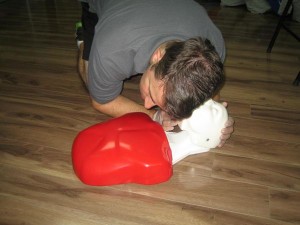Adequate ventilation and effective airway management are dependent on free

movement of air through the upper and lower airways. In many disorders, the airway becomes narrowed or blocked as a result of various disease conditions such as bronchoconstriction (narrowing of the airway by contraction of muscle fibers), a foreign body or copious amounts of secretions.
Effective airway management and a patent (open) airway is better achieved through thorough and scrupulous airway management, whether in an emergency situation such as an airway obstruction or in long term management such as in caring for individuals with an endotracheal or tracheotomy tube. The significance of keeping a patent airway is imperative for survival and maintaining life. It is the primary duty of the health provider in constantly monitoring the airway of a patient in situations whether that is life threatening as well as continuity of care for individuals with airway support.
Possible causes that require emergency airway management
Emergency airway management of the upper airway is very important in cases of airway obstruction. Upper airway obstruction has a variety of causes which may include food particles, vomitus, blood clots or any other particle that enters and obstructs the trachea and larynx. It may also occur from an enlargement of tissue in the wall of the underlying tissues of the respiratory tract as in epiglottitis, obstructive sleep apnea, laryngeal edema, laryngeal carcinoma, or peritonsillar abscess or from thick, copious secretions. Moreover, the pressure on the walls of the airway as a normal occurrence in goiter, enlarged lymph nodes in the mediastinal region, hematoma around the upper airway and thoracic aneurism may also result in obstruction of the upper airway which requires emergency airway management.
Emergency airway management of upper airway obstruction
The patient with an altered level of consciousness due to an altered upper airway obstruction will require an immediate airway management because of the great risk of losing the protective cough and swallowing reflexes as well as loss of the tone of the pharyngeal muscles which causes the tongue to fall back to the oropharynx and block the airway. Just like any other emergency situation, the concept of ABC has been the paramount consideration when caring for an individual whose predisposition is unknown. Likewise, in any existing respiratory condition whether emergent or not, care and management of the airway should be first prioritized. It is imperative that health care providers have intermediate to expert skills in properly maintaining adequate and a patent airway.
Rapid assessment in upper airway management
The health care provider, specifically the trauma nurse/emergency room nurse should make the following rapid observation to assess for signs and symptoms of upper airway obstruction:
- Inspection: Is the patient unconscious? Is there any inspiratory effort? Does the chest rise symmetrically? Is there use or retraction of accessory muscles? What is the skin color? Are there any obvious signs of deformity or obstruction? Is the trachea midline?
- Palpation: Do both sides of the chest rise equally with inspiration? Are there any specific areas of tenderness, fracture or subcutaneous emphysema?
- Auscultation: Is there any audible air movement, stridor (inspiratory sound), or wheezing (expiratory sound)? Are breath sounds present over the lower trachea and bilaterally in all lobes of the lungs?
As soon as an upper airway obstruction is identified upon the assessment, the health care provider (nurse) along with other members of the health care team should take emergency measures in airway management to maintain a patent airway and effective gas exchange.
